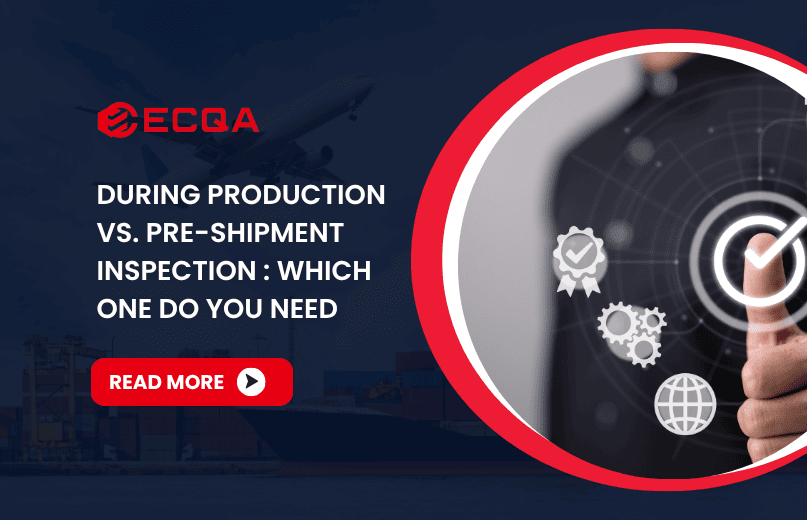
During Production VS. Pre-Shipment Inspection : Which One Do You Need
During Production Inspection happens during production. Pre-shipment inspection happens after production is complete. Both aim to prevent defective products from reaching customers. The difference lies in when problems are identified and corrected.
Getting inspection timing wrong costs money. Discovering defects after production leads to delays, expensive rework, and sometimes total order losses. Finding problems early helps fix issues before they multiply. Every manufacturing business must decide: inspect during production, after production, or both?

What is During Production Inspection?
Definition and Core Purpose
During Production inspection, also known as inline inspection or In-Process Inspection, takes place while manufacturing is still ongoing. Instead of waiting until all products are completed, inspectors evaluate samples at various stages of production. The purpose is clear: identify defects early, prevent larger quality issues, and ensure production stays on track before significant resources are wasted.
Catching problems mid-production gives manufacturers a critical advantage. Defects that appear early in the process can often be corrected with minimal cost and disruption. If issues are not caught until the end, they may affect the entire batch, leading to costly rework, wasted materials, and missed deadlines.
Key Features of During Production Inspection
- Sampling at multiple production stages: Inspections typically start with raw material checks, followed by inspections during early production, midway through, and before final assembly is complete.
- Process monitoring: Inspectors observe how production is being carried out, making sure machines function correctly, workers follow procedures, and assembly meets defined standards.
- Material verification: All incoming components and raw materials are checked to ensure they meet technical specifications before production even starts.
- Real-time defect prevention: Continuous inspection allows manufacturers to catch process deviations, machine malfunctions, and workmanship issues as they happen.
Benefits of During Production Inspection
- Early problem detection: The sooner a defect is found, the easier and cheaper it is to fix. DPI helps prevent small issues from turning into major failures.
- Lower rework costs: Fixing problems during production requires far less time and money compared to reworking finished products.
- Prevention of large-scale downtime: Stopping production for major repairs can be expensive. Continuous inspections help prevent full-line shutdowns.
- Improved supplier accountability: Suppliers are more likely to maintain high standards when they know that inspectors are monitoring production in real-time.
Challenges and Limitations of During Production Inspection
- Requires skilled on-site inspectors: Effective in-process inspections demand trained professionals who can recognize technical and procedural flaws.
- Higher ongoing costs: Since inspections happen repeatedly throughout production, they can be more expensive compared to a one-time final check.
- May not catch final-stage defects: Some issues only become visible after products are fully assembled and packaged, meaning DPI alone may not catch everything.
When to Use During Production Inspection
During Production Inspection is not always necessary for every type of production. It becomes essential under certain conditions where risks are higher.
- Complex manufacturing processes: Products that involve multiple assembly steps, intricate components, or tight tolerances—such as electronics, automotive parts, or industrial machinery—benefit the most from in-process inspection. A small error early in the process can ruin an entire system if left unchecked.
- First production runs: When manufacturing a product for the first time, designs may be untested and processes still in development. During production inspection helps stabilize quality before mass production fully ramps up.
- High customization or frequent design changes: Custom products or items that regularly undergo design modifications introduce new risks with each change. DPI ensures each variation maintains expected quality levels.
- Strict regulatory compliance: Industries like medical devices, aerospace, and pharmaceuticals face severe penalties for quality failures. DPI helps ensure every regulatory requirement is met long before products reach the final inspection stage.
- High cost of failure: In industries where recalls, returns, or product failures can lead to huge financial losses or safety risks, catching issues early is non-negotiable.
What Is Pre-Shipment Inspection?
Definition and Core Purpose
Pre-shipment inspection (PSI) happens after production is complete but before products leave the factory. It is the final line of defense before goods are packed, shipped, and delivered to customers. Inspectors evaluate finished products to verify they meet the buyer’s quality requirements, safety standards, labeling, packaging, and compliance regulations.
At this stage, no production is happening. All goods are fully assembled and ready for export. The main goal is simple: make sure only acceptable products are shipped. If defects are found, the supplier still has a chance to rework or replace items before shipment.
Key Features of Pre-Shipment Inspection
- Finished goods sampling: Inspectors select a random sample of completed products, often using the internationally recognized AQL (Acceptable Quality Level) system to ensure the sample size represents the entire batch.
- Visual inspection: Every item is visually checked for physical defects, workmanship issues, missing parts, incorrect assembly, or cosmetic flaws.
- Functionality testing: Depending on the product, inspectors may perform basic functional tests to ensure the product works as intended.
- Packaging verification: Cartons, individual packaging, labels, barcodes, and shipping marks are checked for accuracy and durability.
- Quantity verification: Confirm that the correct quantity has been produced and packed.
- Compliance checks: For products that must meet regulatory standards (such as safety, labeling, or certification requirements), inspectors verify necessary documentation and markings are accurate and complete.
Benefits of Pre-Shipment Inspection
- Cost-effective for importers: PSI provides a comprehensive quality check without requiring ongoing monitoring during production. One inspection at the end is often enough for mature, stable manufacturing processes.
- Prevents defective shipments: Problems are caught before goods leave the supplier’s facility, reducing the risk of receiving defective or non-compliant shipments.
- Minimizes client-side disputes: A documented inspection report protects both buyers and suppliers, clearly identifying quality issues before shipment.
- Works well for standardized products: For products with mature production lines, repeat orders, and consistent quality, pre-shipment inspection is usually sufficient.
Challenges and Limitations of Pre-Shipment Inspection
- Limited corrective action time: If major issues are discovered at the pre-shipment stage, correcting them may delay delivery or require costly rework.
- Deep-rooted production problems remain hidden: If systemic issues occurred earlier in production and went undetected, PSI may only reveal symptoms, not causes.
- Higher risk if serious defects are found late: The later defects are found, the fewer options exist to fix them without affecting shipment schedules, customer satisfaction, and costs.
When to Use Pre-Shipment Inspection
Pre-shipment inspection is suitable for many manufacturing scenarios, but works best under certain conditions:
- Mature and stable production lines: If a factory has already produced the same product many times with consistent quality, inspecting only at the end may be sufficient.
- Standardized consumer goods: Apparel, home goods, toys, furniture, promotional items, and mass-produced consumer electronics often follow stable production processes. PSI ensures the final product matches specifications.
- Well-established supplier relationships: Long-term partners with a strong quality history may require less ongoing monitoring during production.
- Cost-sensitive orders: When budgets are tight, pre-shipment inspection offers a way to control quality without continuous, expensive monitoring throughout production.
During Production vs Pre-Shipment Inspection
Choosing between During Production inspection and pre-shipment inspection depends on the product type, production complexity, supplier capability, and your tolerance for risk. Here’s a clear side-by-side comparison to help you decide which inspection method best fits your situation:
| Factor | During Production Inspection (DPI) | Pre-Shipment Inspection (PSI) |
| Timing | During production | After production is complete |
| Main Purpose | Prevent defects early | Verify finished product quality |
| Cost | Higher (continuous inspections throughout production) | Lower (one-time inspection before shipment) |
| Risk Exposure | Lower (issues caught early) | Higher (issues discovered late may cause delays) |
| Corrective Window | Large (ample time to fix problems before full production is completed) | Limited (repairs after production are time-consuming and costly) |
| Suitable For | Complex or new products, customized orders, first production runs, highly regulated industries | Mature, stable production lines, mass-produced consumer goods, repeat orders with trusted suppliers |
Both inspection methods serve critical roles depending on the scenario. During production inspection gives better control and earlier intervention. Pre-shipment inspection offers final assurance that finished goods meet expectations before they are shipped.
Of course, these are just two stages within the broader framework of quality control. If you want a full overview, you can also explore the 4 Types of Quality Inspection to understand how each inspection fits into a complete quality assurance strategy.
Inspection timing is not just a quality control decision. It is a risk management strategy. Choosing the right inspection method at the right stage protects your business, your supply chain, and your long-term profitability.
If you are unsure which inspection approach fits your business best, partner with experienced quality control professionals like ECQA who understand your industry, your products, and your unique risks. The right guidance can save you from costly mistakes before they happen.

 Request Free Sample Report
Request Free Sample Report